No poverty of approaches
As October advanced I noticed more and more poverty weed bushes (Baccharis neglecta) putting out their many little white flowers. The typical visual effect is shown above in a view from alongside Bull Creek on October 14th. Notice the characteristic herringbone pattern of the branches at the right. Overnight rain had left the bushes wet, and I took advantage of that to do closeups of sodden poverty weed flowers.
As different as the last two photographs look, I took both of them at f/22 using flash. In the bottom view I aimed upward toward the cloudy-bright sky; in the middle photograph I aimed sideways.
⧖
⧖ ⧖
⧖ ⧖ ⧖
⧖ ⧖
⧖
“For the contemporary reader, much of English literature can induce a kind of moral peanut allergy.” That’s one zinger from Michael Lewis’s article in the November 2021 issue of Commentary, “Wokeness and the English Language,” which I recommend.
© 2021 Steven Schwartzman



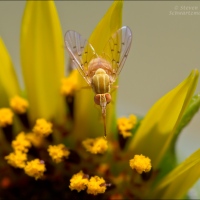
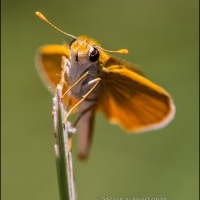

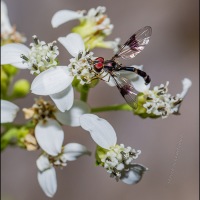
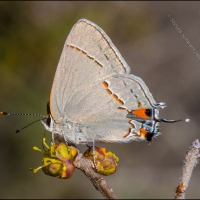
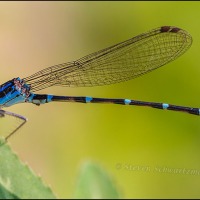

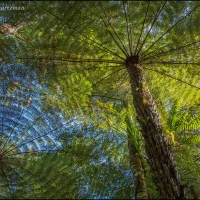
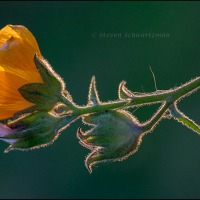
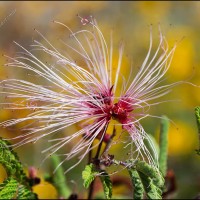
No poverty in your daily photography accomplishments!
Peter Klopp
October 29, 2021 at 9:23 AM
Thanks so much for your appreciation. I keep chugging away.
Steve Schwartzman
October 29, 2021 at 12:29 PM
Poverty weed seems to be a rather odd name for a plant, and it is also called New Deal weed and Roosevelt weed. I was curious how these common names became applied to this plant, and found a couple sources that state that this plant was used during the Dust Bowl days of the 1930s for soil erosion control. And the 30s were the time of FDR and the New Deal.
Tom Lebsack
October 29, 2021 at 2:30 PM
The explanation I’ve read is that after many homesteaders went broke on the Great Plains in the 1930s and left their properties, Baccharis neglecta was very good at colonizing the abandoned land. I’ve seen it do that along Lake Travis when land that had been underwater got exposed during a drought. The explanation you found seems plausible, too, and the two aren’t mutually exclusive.
Steve Schwartzman
October 29, 2021 at 3:00 PM
Nice set of photos, Steve. I like this plant and always forget its name. I guess I have a ‘poverty’ of memory, for at least some things. 🙂
Tina
October 29, 2021 at 2:49 PM
But now your memory has been enriched and I believe you won’t forget this plant any more. It’s at its peak now, as I can corroborate from wandering around taking pictures of it in Cedar Park this morning.
Steve Schwartzman
October 29, 2021 at 2:55 PM
I saw some in the Hill Country and the area in and around Lost Maples this week.
Tina
October 29, 2021 at 4:49 PM
It’s good to hear you got out for some Hill Country scenery. I gather from the Lost Maples website that most fall color there is still ahead. Is that what you found?
Steve Schwartzman
October 29, 2021 at 5:48 PM
Yes, the maples were green, but sycamore were yellow, Virginia creeper was red and all the grasses and fall bloomers were in fine form. It was gorgeous!! Also visited a native plants nursery just out of Kerrville and snagged some plants I haven’t been able to find here!
Tina
October 29, 2021 at 5:57 PM
Sounds like a lovely and productive visit. Presumably the plants you got in Kerrville will show up in your posts in the years to come. I remember yellow sycamores at Lost Maples from a fall visit years ago. I’m surprised that the Virginia creeper there has reddened already. No such luck so far with the ones in our yard.
Steve Schwartzman
October 29, 2021 at 8:44 PM
Each makes it look as if it’s a different plant completely. I love the first image but, then I love grasses.
I agree with Peter Klopp!! 😀
circadianreflections
October 29, 2021 at 3:07 PM
Unity in multiplicity, we might say, or the parable of the blind men and the poverty weed. These delicate trees are at their peak in Austin now, so I went out taking even more pictures this morning. In a while I’ll follow up on today’s post with one or two more of poverty weed’s looks.
Thanks for seconding Peter.
Steve Schwartzman
October 29, 2021 at 3:47 PM
The many faces of poverty weed. Make sure you keep your lawn mowed, Steve!
Steve Gingold
October 29, 2021 at 5:20 PM
My lawn but not my thoughts.
Steve Schwartzman
October 29, 2021 at 5:45 PM
Not sure if you got the reference. Do you have a HOA in your neighborhood?
Steve Gingold
October 29, 2021 at 5:57 PM
I’d wondered what you were getting at. Fortunately our home isn’t part of any HOA, so I haven’t had to contend with unreasonable restrictions. There was a case in Austin years ago where an HOA got after a homeowner for filling his front yard with bluebonnets, the official state wildflower of Texas.
Steve Schwartzman
October 29, 2021 at 8:37 PM
I am still not sure if you got the connection. A guy in Austin didn’t mow his lawn as required by his HOA so they had the police visit him. For some reason they started mowing his lawn and that led to gunfire and he was killed….over his grass. A senseless death, a restriction on someone’s freedom of choice (although he did sign the agreement), and just a terrible situation. People are too quick to get angry and fight these days. Or maybe they have always been that way but it seems heightened. Definitely too quick to use a gun.
Steve Gingold
October 30, 2021 at 3:10 AM
You’re right: I hadn’t heard about this strange incident and therefore hadn’t gotten the connection. I just looked it up:
https://www.kxan.com/news/local/austin/man-in-swat-situation-had-no-violent-history-during-code-visits-officials-say/
You can see in the video that the fire destroyed the house. I assume the man decided to die and burned down his own house. According to the story, he’d gotten along with his neighbors and had no history of violence. What a shame.
Steve Schwartzman
October 30, 2021 at 3:28 AM
My next door neighbor is just the opposite about his lawn. Mows it three or four times a week. We wish he would let it grow more. That man had some mental issue obviously to exchange gunfire with police, torch his house, and then die over the length of the grass.
Steve Gingold
October 30, 2021 at 3:48 AM
I wonder if the pandemic weakened his mental stability.
Steve Schwartzman
October 30, 2021 at 4:03 AM
Entirely possible. I think we’ve seen a lot of changes in society as a result of that. Some were already festering below the surface and some actual manifestations of the experience wrought by the virus. It certainly has turned a lot of people against others and brought out the worst in many.
Steve Gingold
October 30, 2021 at 6:43 AM
And alas, I don’t see prospects for a diminishing of that.
Steve Schwartzman
October 30, 2021 at 8:08 AM
I’m so intrigued by that last photo. Absent any context, I don’t think I would have recognized it as poverty weed. On the other hand, it’s interesting that you mentioned the herringbone pattern in the first photo, while my attention was captured by the bending branches at the left. They brought to mind William Morris; the pattern seems very much like something he would have created for his printing or textiles.
shoreacres
November 2, 2021 at 7:09 AM
As intrigued as I’ve been for two decades by poverty weed’s fall fluff, I soon noticed distinctive the herringbone pattern of the branches. I’m willing to entertain the idea that the third picture is unique, as I, like you, haven’t seen poverty weed portrayed that way anywhere else. Mostly I’ve played off the fluff against darker backgrounds, or against a blue sky. This time I did off-white against light grey.
Steve Schwartzman
November 2, 2021 at 7:27 AM
[…] October 14th I photographed some wet poverty weed (Baccharis neglecta) flowering along Bull Creek under overcast skies. As the month advanced, many […]
Sunny poverty weed | Portraits of Wildflowers
November 17, 2021 at 4:40 AM